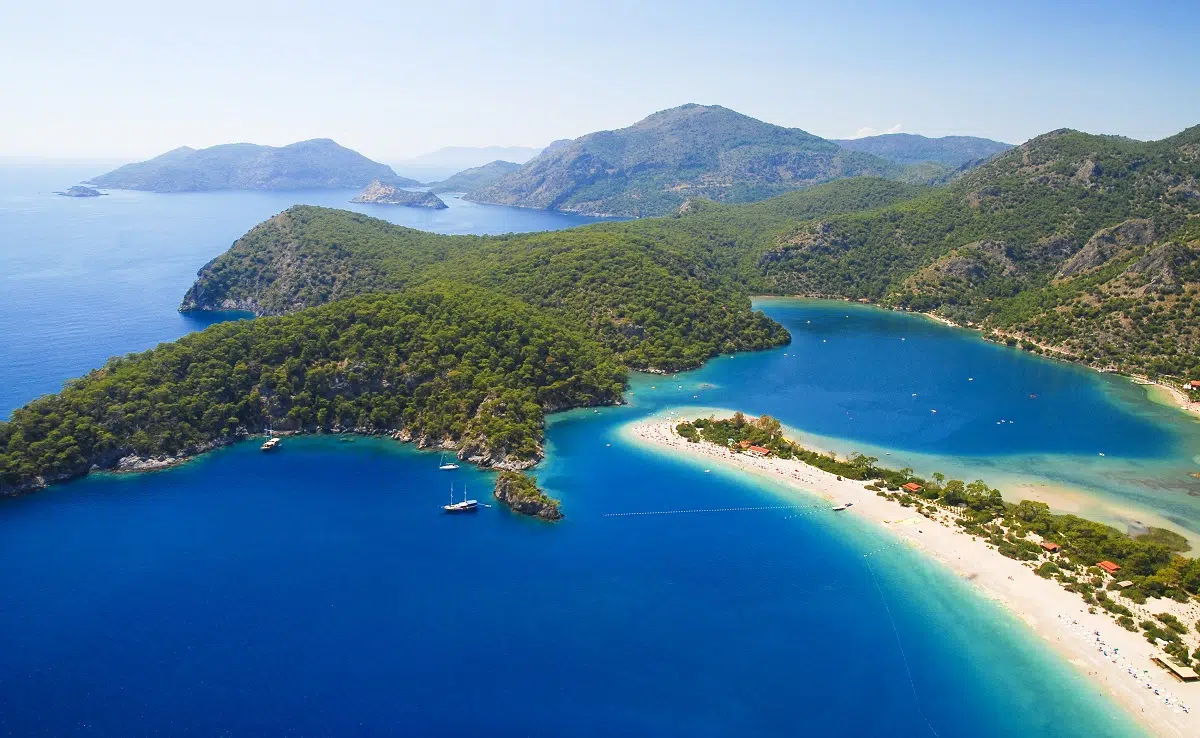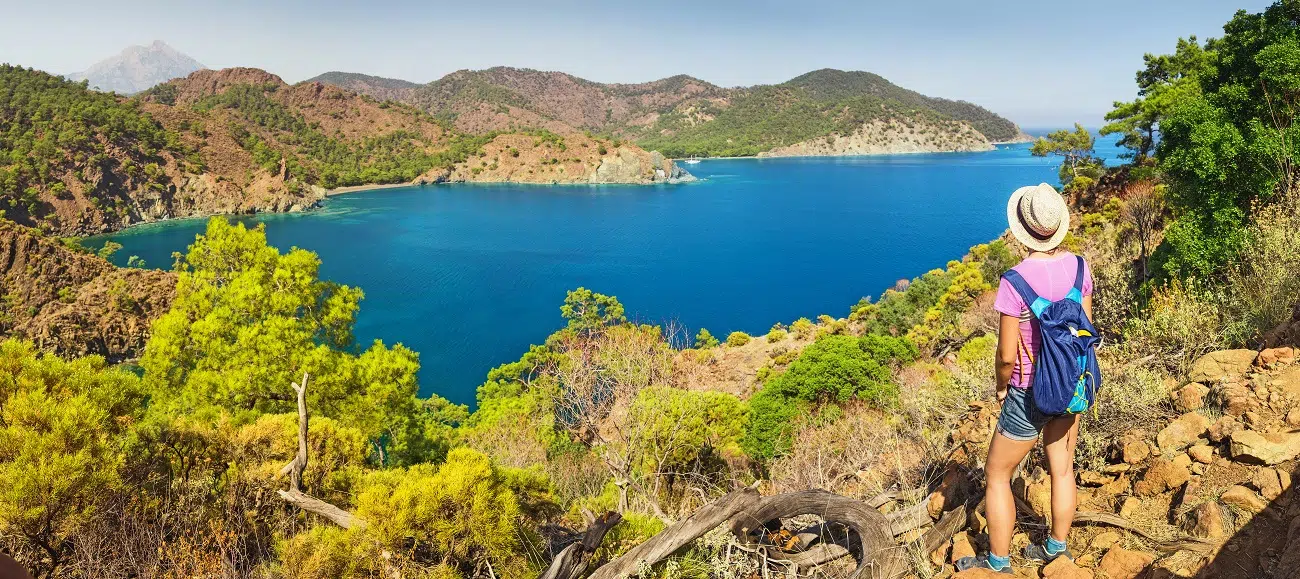The Lycian Coast of Turkey
The Lycian coast of Turkey refers aptly to the area in the Mediterranean region that was formerly governed by the Lycian empire from approximately the 15th century BC to 546BC. Also known as the South-Aegean coast or the turquoise coast, it lies in the province of Mugla. Although it has not been verified, historians strongly suspect their demise came about, when their cities were invaded by Harpogos, a median general that is credited with having put Cyrus the Great on the throne of Persia. His story is elegantly told in a book by Atulya K Bingham, who recounts her friend’s story of having hiked the Lycian way in present times. Other than that, tell-tale signs of their existence can be seen all over the stretch of coastline which is truly spectacular.

Rugged cliffs of pine forests plunge into the turquoise sea, between them are small bays of sand and shingle accessible only by boat. In ancient times the Lycians, mentioned in Homer’s Iliad, settled here and the ruins of their cities and majestic rock tombs can easily be seen. The arrival of the coastal road, though, has led to the opening up of once-isolated fishing villages, while resorts are still on a small scale, they are becoming more developed. However, the cobbled narrow backstreets, the memorable call to prayer from the mosques and the friendly locals combine to make for a relaxing holiday and an adventure.
The World Famous Lycian Trek
Recognized by the Sunday Times as one of the best 10 walks in the world, the 516 km official trek stems from the region of Antalya to Fethiye. Along the way, walkers visit some of the most breath-taking landscape scenery as well as hundreds of historical sites built by the Lycian Empire. Xanthos, that was the centre of the Lycian empire has unearthed some of the most exquisite artefacts including the tomb of Pavaya, that is now in the British history museum. Four km away is Letoon, the most important religious sanctuary of its time.
Fethiye is the primary city of the region; surrounded by verdant mountains, Lycian ruins, and turquoise sea; it’s the gateway to Ölüdeniz, the Blue Lagoon. Near to Fethiye sits Tlos, with its large Lycian rock tombs overlooking the Xanthos Valley and Patara that was a key trading centre, thanks to its seaside port location is also allocated for more excavation works. Kayakoy is an abandoned village with hundreds of partially ruined houses south of Fethiye it is often referred to as “The ghost town of Kayakoy”. Saklikent (Hidden City) Gorge is the second-largest in Europe its 20 km-long and is the longest and deepest gorge in Turkey, about a 40 minutes’ drive from Fethiye. It is a spectacular place, with 4km of sculpted walls, the gorge is best visited after April when most of the snow from the Taurus Mountains has melted and passed through the gorge on its way to the Xanthos River. Summer is the best time to visit as the canyon as its shaded and you can take a leisurely walk.
The ancient city of Myra, further up the coastline in an area known as Demre, it has a magnificent theatre and the rock tombs but is also famous for the church of Saint Nicholas, otherwise known as Santa Claus, who was the Bishop of the region.

Resorts of the Lycian coast
Towns and villages sitting on the Lycian coast, have four advantages. Not only do they belong to the Lycian way but also the Turkish Riviera that is a popular sailing centre for yachts from all around the world. Thirdly, sitting on the Mediterranean coast, they enjoy admiration as the second most popular holiday destination in Turkey, after Istanbul. Lastly, the major coastal road called the D400 connects towns, village and cities, providing easy transportation and access, which in turn boosts visitors looking to complete self-drive holidays of Turkey.
Some resorts have maintained a quiet and dignified appearance such as Cirali, which is a one-street village, while the neighbouring resort of Olympos started its claim to fame in the seventies when backpacking hippies flocked there for the vibes of living off the land and being at one with nature, today it’s a backpackers dream destination its full of wooden tree-houses and bustling nightlife. Dalyan is a beautiful spot and has miles of channels meandering around marshlands and the beach is where endangered caretta caretta turtles lay eggs, and nearby rock tombs are engraved on the hillsides
Places like Gocek and Kalkan are promoted as upmarket destinations and this is evident in the luxury boats living in the marinas, Gocek is known as a yachter’s mecca located on the tip of the bay with plenty of secluded coves and small islands which are covered with pine forests. Kalkan has a typically Mediterranean feel about it with its whitewashed houses and brightly coloured flowers. Many wealthy Turks have purchased second-holiday homes in those areas, while resorts such as Olu Deniz, and Calis are middle market and attract mainly British clientele, who like the vibes and atmosphere of their home country that restaurants, bars and hotels have provided in order to attract more holidaymakers.
Faralya is a village in Lycia it is about 15 km south of Ölüdeniz (and 30 km south of Fethiye), Faralya was known as the “village on the cliffs of the Butterfly Valley” a deep canyon with sea on one side and some rare butterflies with the only access from the sea or a difficult climb down to the canyon via a narrow path. Carry on 8 km further south and you find Kabak which consists of two physically separate sections: a settlement which is a small cluster of two-story buildings along the road, clinging on a mountainside way above the coastline with panoramic views of beautiful Mediterranean and between the coast and the canyon is Kabak Koyu, which, with its pine groves, waterfalls, and coastline, is similar to more famous Butterfly Valley of Faralya.
No doubt the most favourite area of the Lycian coast is Antalya, a destination with a knack for accommodating all nationalities and types of holiday makers. Adventure sport lovers flock to places like Koprulu canyon while history enthusiasts admire Aspendos and Phaselis, an ancient sea trading port deserted after constant attacks by pirates. The city centre is a major hub for business, tourism and transport, while the smaller resorts, like Kemer, are respected for their beaches. Anyone considering a visit to the Lycian coast will surely find what they are looking for whether it is beautiful landscapes, historical value or simply a taste of Mediterranean living.
The weather is a typical Mediterranean climate and the further South you head towards Antalya the more humid it becomes. The summers are hot and long and the winters are cool and mild. Dalaman airport serves most of the Lycian area however as you go further east you can use Antalya international airport. Getting around is made effortless with the local bus service called a Dolmus, these buses are both reliable and inexpensive and ideal for journeys in the vicinity or further afield.
Related Area Guides in Turkey
You can visit Rhodes and some of the smaller Greek islands which lie just off the Lycian coast by using the services of the direct ferries from a number of the Turkish harbour resorts. The Lycian coast offers an abundance of colourful rich history, stunning sand beaches and views of the Mediterranean, nature and wildlife, plus places of interest it’s a gem in Turkey’s crown!
Antalya:
Apartments for sale in Antalya, Turkey
Villas for sale in Antalya, Turkey
Property for sale in Antalya, Turkey
Fethiye:
Apartments for sale in Fethiye, Turkey
Villas for sale in Fethiye, Turkey
Property for sale in Fethiye, Turkey
Kalkan:
Apartments for sale in Kalkan, Turkey
Villas for sale in Kalkan, Turkey
Property for sale in Kalkan, Turkey
Antalya Province:
Apartments for sale in Antalya Province, Turkey
Villas for sale in Antalya Province, Turkey
Property for sale in Antalya Province, Turkey
Mugla:
Property for sale in Mugla, Turkey
Property for sale in Turkey:
Property for sale in Turkey
